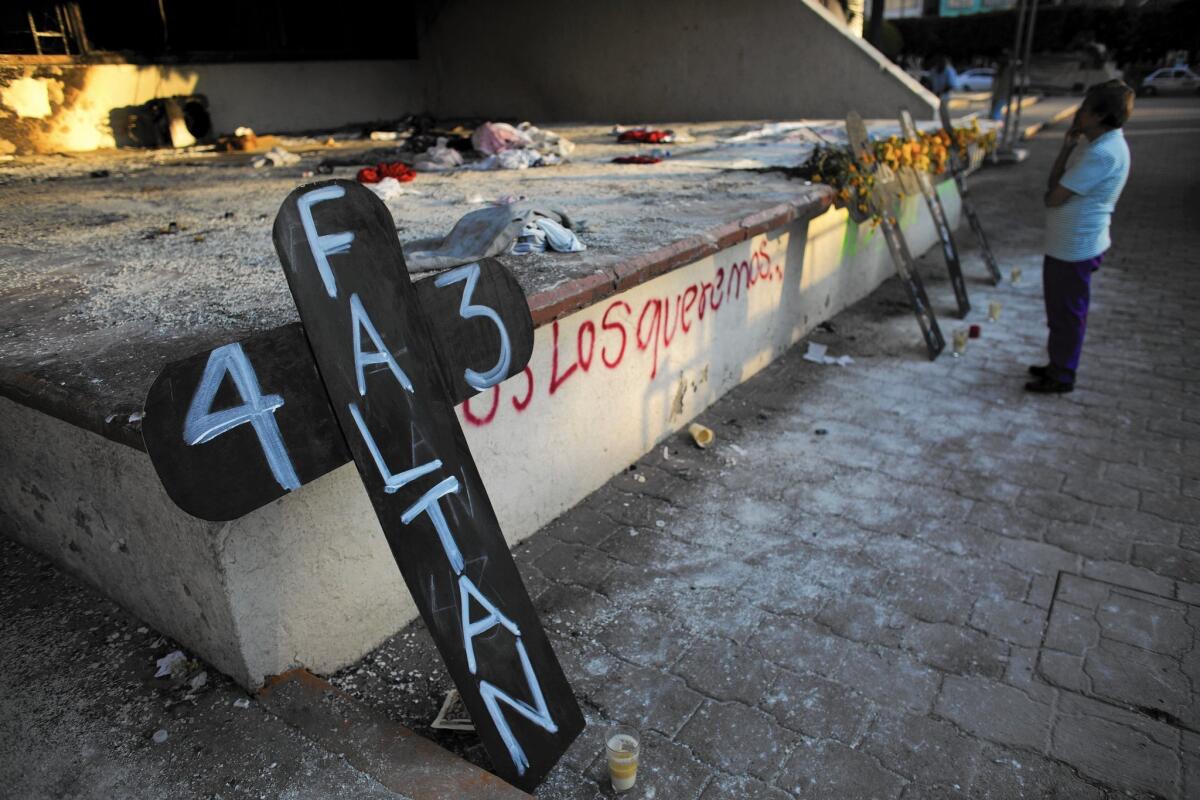A day of too many dead in Mexico

- Share via
IGUALA, Mexico — This time, there are not enough candles, not enough wreaths, altars or prayers to recognize the dead.
The dead and the likely dead are all around this small, scruffy city. Clandestine graves dot the hillsides like the wild yellow flowers that blanket endless fields. One day inspectors comb through trash in a huge garbage dump; the next day, they dredge the river.
Searching for bodies.
“The hills of Iguala are a cemetery,” said Lino Ponce Gonzalez, part of a community police force helping in and sometimes leading the search here in central Mexico’s Guerrero state. His 25-year-old sister was kidnapped and disappeared a year and four months ago, and a brother was killed with 28 machete cuts six years ago.
“Dead or alive, I just want to find her,” he said of his sister, breaking down into tears when he described a corpse in the government morgue said to have her hair, her clothes. But authorities won’t give him closure, won’t let him see, he said.
Sunday is the Day of the Dead, one of this country’s most cherished holidays, when Mexicans remember and honor their deceased. Here in Iguala, cradle of the Mexican Revolution a century ago, the holiday this year is overshadowed by the disappearance of 43 college students, rounded up by local police on Sept. 26, allegedly on orders of the mayor, and not seen since.
“It is a nightmare, hard to believe that we ever lived here,” said Alicia Mejia Ortiz, as she watched her friends, two sisters, tidy up the tombstone of their grandparents, sister and niece in the Old Iguala Cemetery in preparation for Sunday’s festivities.
That the children of so many parents, she said, could be simply taken away is unfathomable, something she would never have thought possible in her town about 120 miles south of Mexico City.
“This is the drop that overflowed the glass,” she said. “Even we are surprised at the number of grave sites.”
Authorities say they have found 38 bodies so far in Iguala.
Her friends swept leaves from the tomb, washed it with soapy water and decorated the site with fresh flowers. The family name, Carranco Garcia, was carved into the stone, along with “Perpetuidad” — perpetuity.
Mexican Atty. Gen. Jesus Murillo Karam says 10,000 soldiers, marines, federal police and other authorities are now working in Guerrero as the government becomes increasingly aware that it must counter the awful publicity that the students’ disappearance and likely massacre has brought.
The discovery of so many hidden graves after the disappearance of the students was not unexpected for many here. Hiding the dead — those killed in gun battles between rival gangs, or innocents killed after being kidnapped, or women killed after their use as sexual slaves ends — all of that is par for the course. An estimated 26,000 people have been reported missing since 2006, when the Mexican government launched its frontal assault against drug cartels and their cohorts.
“This is the story of Guerrero,” said Ponce, the police officer, alluding to the grave sites, “but also of Chihuahua, Sonora … “ he added, ticking off the names of Mexican states that have been seized in the grips of drug gangs and corrupt officials.
The families of the 43 missing students met Thursday with President Enrique Peña Nieto, who had little progress to report. They remain desperate and hopeful that some good will come of official and unofficial search efforts.
“It is the impotence of not being able to do anything,” Ponce said. “I’m sure they feel desperate, and I can only wish them courage.”
Federal authorities, hoping to assuage the tensions, are spreading out in the streets of Iguala and nearby Cocula, where it was reported the bodies of the students might be. (So far, no.) Members of the new gendarmerie of militarized police went door to door this week, handing out business cards so that residents could call anonymously if they saw anything that might lead to the discovery of the students.
“We are looking for live people,” commander Manelich Castilla, the top gendarmerie official in the region, said as he walked amid stalls in Iguala’s produce market.
Sergio Fajardo, an Iguala businessman who led a march Wednesday to demand peace for the city, said the profound problems of deep police and political corruption “cannot be wiped out with a mop.”
“There are plenty of mass graves to find,” he said. “You can find lots of dead.”
Normally, the Day of the Dead ceremony in Iguala would be a festive affair, awash in colors of orange, yellow and white to honor those who have passed. Normally, there are mock tombs in the central plaza to symbolize all of the dead.
This year, however, there are three oversized crosses representing the missing students. There is a circle of burned candles. The government building on the side of the square is charred and burned out, from protests by students and their supporters.
“This year,” said Napoleon Hernandez, another community policeman, “there are not enough candles.”
More to Read
Sign up for Essential California
The most important California stories and recommendations in your inbox every morning.
You may occasionally receive promotional content from the Los Angeles Times.











